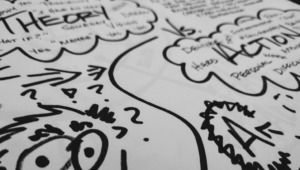The 10 Elements: Forward Lean Versus Fast Retreat

This post originally appeared on The EdFly Blog
Three years ago I changed the name of my blog from edReformer to Getting Smart. Rather than focusing on fixing the crazy patchwork education system we have, I decided to focus forward on innovation. We’re living through the most important and most exciting learning revolution in history—this is bigger than the printing press, and it’s happening over just one generation rather than over centuries. The chance to create new tools and new schools that work better for students and teachers has never been better. In this decade we have the opportunity to dramatically improve education in Detroit as well as Delhi.
One person that understands the opportunity set is Governor Jeb Bush. I visited him 40 months ago and he said that state policy makers were encouraged by emerging opportunities but were seeking advice. He suggested a coherent policy framework for the future. I told him that policy advocacy projects like the Data Quality Campaign had made a big difference in encouraging states to build better data systems.
The Digital Learning Council was born the next week and Governor Bob Wise joined as co-chair. Over the course of the next 100 days, 100 advisors participated in about 50 web conferences. The bipartisan effort included many of our country’s best educators, philanthropists, policy makers, advocates, and technologies in the country.
Each of those web conferences included debates on tough details of what soon became the 10 Elements of High Quality Digital Learning. Members of the steering committee made a conscious effort to write the final document with an aspirational tone but a focus on all students.
In Diane Ravitch’s newly released book, Reign of Error, Ravitch treats the 10 Elements as “a Bill of Rights for Online Providers” and equates digital learning nearly solely as virtual schools. This mischaracterization does a disservice to everyone that was involved in the process.
In the end, there were three of the 100 advisors that said they could not sign on to the forward leaning platform. As representatives of membership groups, their concern was understandable. Their views were considered on every call and on every point.
The members of the Digital Learning Council recognized that we are early in a shift to personal digital learning where every student will soon benefit from 24/7 access to the best learning opportunities and where most will attend a public school that blends the best of online and onsite learning.
What I find distasteful about the Ravitch flip flop is that there is no theory of improvement. She complains about everything, yet doesn’t offer a constructive path forward. She fails my basic debate test: Tell me how things get better for all kids, regardless of socioeconomic status, disabilities, or geography.
The 10 Elements of High Quality Digital Learning remain the best bipartisan roadmap of a policy set that will yield improvement, innovation, and opportunity.
For a more balanced and dispassionate review of the subject, see Hess and Horn’s Private Enterprise and Public Education.







0 Comments
Leave a Comment
Your email address will not be published. All fields are required.